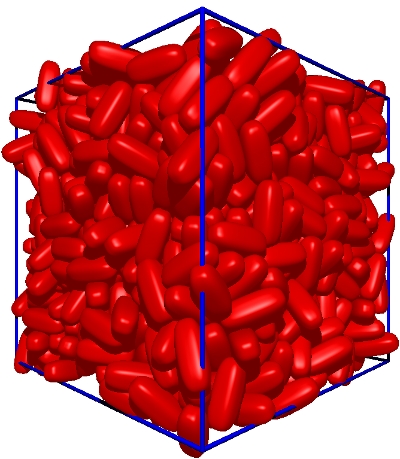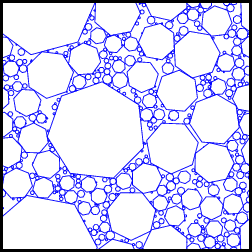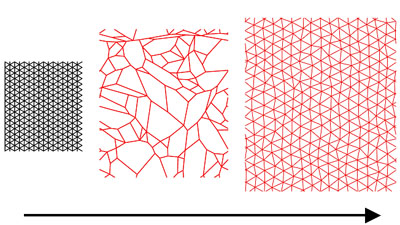
Dr. Gary W. Delaney
Data61, CSIRO Melbourne, Australia.
Research Interests
I lead Data61's Industrial Systems Modelling Team at the Commonwealth
Scientific and Industrial Research
Organisation (CSIRO) in Melbourne. My primary research interests are in computational modelling and structural characterization of granular systems, and
applications of Machine Learning in
understanding and optimizing natural and industrial processes.

Work with collaborators from University of Erlangen-Nuremberg, Max Planck Institute and the Australian National University on the structure of 3D frictional
ellipsoid packings is featured on the cover of the current issue of Physical Review Letters.
Details of this work is given in our paper Local Origin of Global Contact Numbers in Frictional Ellipsoid Packings
.

We investigate the properties of packings of frictionless non-spherical particles utilizing a dynamic particle expansion technique. We employ superquadric particles (superellipsoids), which allows us to explore how a broad range of particle shapes affect both the macroscopic and the local configurational properties of the system. We smoothly transition from spherical particles possessing only translational degrees of freedom to large aspect ratio non-spherical grains where rotational degrees of freedom are highly important. We demonstrate that the degree of anisotropy and local surface curvature of the particles have a profound effect on their packing properties, determining whether a random or an ordered packing is readily formed.
Details of this work is given in our paper The packing properties of superellipsoids
.

Scientists have long considered packing models in which non-overlapping
grains of smaller and smaller sizes are placed according to a specified
set of rules. These date back to the work of Apollonius of Perga ca.
200B.C. We have performed extensive numerical simulations using up
to 106 grains for a range of polygonal
and elliptical shapes using both the traditional Random Apollonian
Packing (RAP) model and also a new model which takes into
account the extra rotational degree of freedom of non-circular grains.
We term this model Rotational Random Apollonian Packing
(RRAP). Grains packed in the RRAP model are observed to
generate denser packings. We explain the dependence of the packing
efficiency on the grain shape via the identification of the key
constraining lengths that limit the growth of the grains during the
packing process. Full details of this work is given
in our paper Relation
Between Grain Shape and Fractal Properties in Random Apollonian Packing
with Grain Rotation.
Random Packing of Ellipses

I have written a software package that employs a Monte-Carlo type
packing
algorithm to generate
dense jammed random packings of 2D grains of arbitrary shape. We have
used this to
investigate the packing properties of elliptical grains,
with a very interesting variation in the packing density of the grains
observed as the ellipticity is varied.
A video of the generation of a packing of ellipses with an
aspect ratio of 0.7 can be downloaded here
( Mpeg 23.6MB). Full details of this work is given
in our paper Random
packing of elliptical disks.
Newton's Cradle - A 1D Granular System

In textbook descriptions of Newton's cradle, it is generally claimed
that
displacing one ball will result in a collision that leads to another
ball
being ejected from the line, with all others remaining motionless. It
has however been shown that a realistic
description is more subtle. We have performed simulations of Newton's
cradle that
reproduce the initial break-up of the line of balls at the first
collision,
the eventual movement of all the balls in phase, and is in good
agreement with our experimentally obtained data. The first effect is
due to the
finite elastic response of the balls, and the second is a result of
viscoelastic
dissipation in the impacts. We have also analyzed a dissipation-free
ideal Newton's
cradle which displays complex dynamics. A video of our simulation can
be downloaded here
( Mpeg 1.46MB). Full details of this work is given
in our paper Rocking
Newton's Cradle.
Onset of Rigidity for Stretched String Networks
 We
have defined and analysed an elementary model which has a close
affinity
to existing models that represent the compression of randomly packed
soft
spheres. That work is mainly founded on
Hooke's Law type interactions which act under compression only. We have
in effect turned this problem "inside-out", by defining Hooke's Law
interactions under extension only, and hence a model of elastic strings
that are loose
under compression. Our simulations consist of a network of strings with
random natural lengths. As this system is expanded, a threshold
is reached where some of the strings form a taut string network. An
animation of the expansion of a triangular network, with the loose
strings colored black and the taut colored red, can be downloaded here
( Gif 5.9MB). Full details of this work is given in
our paper Onset
of rigidity for stretched string networks.
We
have defined and analysed an elementary model which has a close
affinity
to existing models that represent the compression of randomly packed
soft
spheres. That work is mainly founded on
Hooke's Law type interactions which act under compression only. We have
in effect turned this problem "inside-out", by defining Hooke's Law
interactions under extension only, and hence a model of elastic strings
that are loose
under compression. Our simulations consist of a network of strings with
random natural lengths. As this system is expanded, a threshold
is reached where some of the strings form a taut string network. An
animation of the expansion of a triangular network, with the loose
strings colored black and the taut colored red, can be downloaded here
( Gif 5.9MB). Full details of this work is given in
our paper Onset
of rigidity for stretched string networks.
Selected Publications
1. "
Local Origin of Global Contact Numbers in Frictional Ellipsoid Packings",
F.M. Schaller, M. Neudecker, M. Saadatfar, G.W. Delaney, G.E. Schroder-Turk, and M. Schroter
Physical
Review Letters,
114, 158001, 2015.
2. "Onset of rigidity in 3D stretched string
networks",
G. W. Delaney and D. Khoury European Physical Journal B, 86, 44, 2013.
3. "Comparison of permeability of model porous media
between SPH and LB",
P.M. Dupuy, P. Austin, G.W. Delaney and M.P. Schwarz, Computer Physics Communications,
182, 2249-2258, 2012.
4. "Defining Random Loose Packing for Nonspherical
Grains",
G.W. Delaney, J.E. Hilton and P.W. Cleary, Physical Review E,
83, 051305, 2011.
5. "The packing properties of superellipsoids",
G.W. Delaney and P.W. Cleary, Europhysics Letters ,
89, 34002, 2010.
6. "Combining tomographic imaging and DEM simulations to
investigate the structure of experimental sphere packings",
G.W. Delaney, T. Di Matteo and Tomaso Aste, Soft Matter, 6, 2992-3006, 2010.
7. "Disordered spherical bead packs are
anisotropic",
G. E. Schroeder-Turk, W. Mickel, M. Schroeter, G. W. Delaney, M. Saadatfar, T. J. Senden, K. Mecke and T. Aste, Europhysics Letters ,
90, 34001, 2010.
8. "Relation
Between Grain Shape and Fractal Properties in Random Apollonian Packing
with Grain Rotation",
G.W. Delaney, S. Hutzler and T. Aste, Physical
Review Letters,
101, 120602, 2008.
9. "Crystalline
arrangements of microbubbles in monodisperse foams", A. van
der Net, G.W. Delaney, W. Drenckhan, D. Weaire and S. Hutzler,
Colloids and Surfaces A: Physicochemical and Engineering Aspects , 309 , 117-124,
2007.
10. "Onset
of rigidity for stretched string networks", G.W. Delaney, D.
Weaire and S. Hutzler,
Europhysics
Letters , 72 ,
990-996, 2005.
11. "Rheology
of ordered foams on the way to Discrete Microfluidics", W.
Drenckhan, S.J. Cox, G. Delaney, H. Holste, D. Weaire and N. Kern,
Colloids and Surfaces A: Physicochemical and Engineering Aspects , 263 52-64,
2005.
12. "Random
packing of elliptical disks", G. Delaney, D. Weaire, S.
Hutzler and S. Murphy,
Philosophical Magazine Letters ,
85 2005, 89-96, 2005.
13. "
Rocking Newton's Cradle ", S. Hutzler, G. Delaney, D. Weaire
and F. MacLeod,
American Journal Of Physics ,
72 2004, 1508-1516, 2004.
Email: gdelaney "AT" gmail "DOT" com







 We
have defined and analysed an elementary model which has a close
affinity
to existing models that represent the compression of randomly packed
soft
spheres. That work is mainly founded on
Hooke's Law type interactions which act under compression only. We have
in effect turned this problem "inside-out", by defining Hooke's Law
interactions under extension only, and hence a model of elastic strings
that are loose
under compression. Our simulations consist of a network of strings with
random natural lengths. As this system is expanded, a threshold
is reached where some of the strings form a taut string network. An
animation of the expansion of a triangular network, with the loose
strings colored black and the taut colored red, can be downloaded here
( Gif 5.9MB). Full details of this work is given in
our paper Onset
of rigidity for stretched string networks.
We
have defined and analysed an elementary model which has a close
affinity
to existing models that represent the compression of randomly packed
soft
spheres. That work is mainly founded on
Hooke's Law type interactions which act under compression only. We have
in effect turned this problem "inside-out", by defining Hooke's Law
interactions under extension only, and hence a model of elastic strings
that are loose
under compression. Our simulations consist of a network of strings with
random natural lengths. As this system is expanded, a threshold
is reached where some of the strings form a taut string network. An
animation of the expansion of a triangular network, with the loose
strings colored black and the taut colored red, can be downloaded here
( Gif 5.9MB). Full details of this work is given in
our paper Onset
of rigidity for stretched string networks.